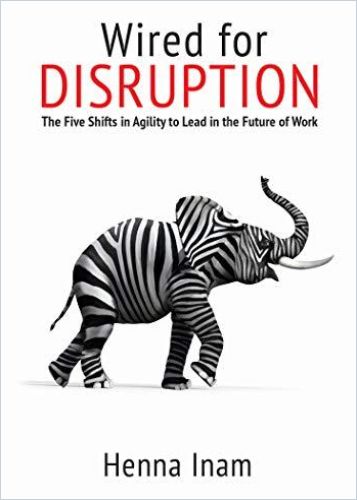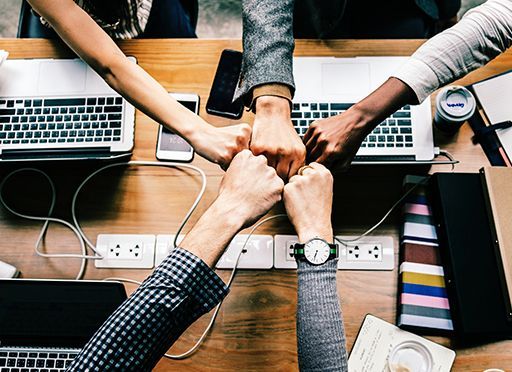“Being Open and Agile Is the One Vital Skill for the 21st Century”

Henna, Wired for Disruption addresses two of the most burning business issues of the day: rapid change – and calm responses to it that are sustainable, not stressed. While the latter is a signature of our pandemic workplace, the first, disruption, is here to stay. But hopefully the stress of dealing with it is not.
Henna Inam: I think you’ve landed on something compelling: Disruption is here. It was extreme and intense in the COVID-19 pandemic. And even now, at a point where there are vaccines, and there’s a light at the end of this tunnel, disruption is far from gone. We will continue to experience disruptions in the future: climate disruption, social disruption – whether it’s about gender equality or racial equality or economic equality, or digital disruption in our workplaces, or even the changing future of work, such as hybrid and flexible working. And my intent in writing Wired for Disruption was to help all of us know that agility is built into our DNA. We can evolve our capacity to thrive in disruption. That’s what we need to create a much more sustainable planet for the future. Human beings need to grow in terms of their ability to respond to disruption.
What does this ability look like, and what does it take to develop it?
At the center of all of our agility skills and capacities lies what I call neuro-emotional agility. We can shift ourselves from states of threat when disruption and stress occur, to states of calm, curiosity, creativity and connectedness. Anytime our body and mind get stressed out, what happens physiologically in our brain and body is that our attention turns very much to survival. Our focus is narrowing, we are becoming tense and everything gears toward a quick response, not a well-considered one.
The result is tunnel vision.
Exactly. Most of the time in most of our days, we use the analytic neural network of our brain, which is the part of our brain that is task-focused: Check that box, next task, next task – moving with a lot of speed in a tunnel. It’s all about efficiency. And it’s beneficial because it helps us get things done. The other part of our brain is our empathic neural network. It is the part of us that feels connected to others, curious, creative. This is based on fMRI-based neuroscience research by Dr. Richard Boyatzis. Now, when one neural network is active, we have less access to the other one. Data also suggests that our ethical decision-making is tempered when we are in the analytic neural network. It is not the best network for being agile to change because we are less able to see the big picture and make good decisions in complexity.
Your advice?
Switch the system! To do so, you have to take two steps. First: Notice what is happening within you. Notice if you’re stuck in fear or anxiety, all of which is totally normal in ambiguous situations where you feel you don’t have control. Your heart races, your face turns red and you may even become aggressive. Then, second: Develop the muscles to shift yourself to a state of being that is much more calm and curious and connected. You can take a few deep breaths and connect with your body to calm yourself. Then connect with a positive emotion like gratitude or inspiration. An example: I remember we went into lockdown in the United States precisely one year ago. I felt as stressed as anyone else. And I sat myself down, and I asked myself: Okay, how can I be helpful to others during this time? What brings me joy? And what are my strengths? The answers to those three questions, which do not only apply when you face a pandemic for the first time in your life, are what I call “The Purpose Accelerator.” It’s one of 15 agility accelerators I share in the book.
When we connect more deeply with purpose and how we can be helpful in any situation, we are no longer focused on our fear.
Henna Inam
In each of our lives, there are moments of transcendence, where we feel connected. We just have to remember them at the right time. This generates states of connection, of beauty, of awe, of wonder – and they are actually neural states in our brain.

And once in those states, we are more likely to see the bigger picture to make better decisions?
Yes. The take-away here is: Human beings want to be helpful by nature. Agility is a built-in feature of our DNA. We are already agile. But to tap into our full potential, we need to learn to become aware of and shift our own neural state. And by the way: If leaders do that, they do not just do it for themselves. They also impact their teams because, as human beings, we have mirror neurons, and we unconsciously mimic each other’s behavior and the behavior of leaders in particular creates the culture in organizations.
That’s why Wired for Disruption is not an ordinary leadership book. It points out that in a work environment, such things as knowledge about neuroscience play an increasingly important role. So how do we redirect our attention to the right parts of our brain when we’re in the stressful place?
There are many ways to do that. But the first step always is to notice. So many of us are spending so much of our time in stress. We don’t even see that we are stressed. There is a famous experiment called “The Boiling Frog Experiment.” If you put a frog in boiling water, it jumps out. But if you let the water boil over time, the frog will cook. And that’s, I think, what a lot of us as human beings are experiencing:
We’re just experiencing chronic stress so that we don’t even know what it’s like to live without it.
Henna Inam
The first thing to do is to recognize that I am in a stressed-out place. The second thing then is to intend to switch out of the state by accepting and processing. The practice of self-compassion helps here. You can say to yourself: “This is a difficult moment. Difficult moments are part of being human. May I be kind to myself.” Many studies have shown the benefits of self-compassion in helping us be more resilient in change. Studies also show that self-compassion helps us be less burned out and also extend compassion toward others. So, shift your attention to positive emotions by asking yourself: What am I grateful for? Who helped me in my life? What gives me comfort? By doing so, you take a step back.
What are you doing, very practically, to take that step?
I have a cat. And so, whenever I get too stressed, I just go pet my cat. (Laughs.) You see, it’s not so much the specific questions as the principle: It’s about taking the step. You will notice then that your body is switching from that place of high-stress mode to at least a neutral state. And then your executive function, the part of your brain that is rational and thinking, can step in again and you can refocus. I also love to take a walk in nature and notice the beauty of nature around me. Exercise is another great way to shift perspective.
It is undoubtedly good if leaders know about this simple trick. But what if they see that their employees are stressed, that they cannot work at their actual level, that their performance suffers? How can they be helped to perform better again?
I know what you mean, but I want to poke at this assumption, a hidden bias that we all have: The notion that we, as human beings, are like machines and that a human beings’ job is to be productive and efficient. That’s like the old thinking of the industrial age. It’s embedded in our thinking. “How can I make my people productive?” But when I say that, I’m seeing my people as an object. You wouldn’t ask this question if it was about your children, right?
No. At least not this way.
Because you care for your children, you care for who they are, right? They’re human. And my challenge to us as leaders is to become aware of this bias in terms of how we see the people in our charge. They aren’t objects, and they aren’t tasks. And that is part of the shift to the empathic neural network: Seeing somebody as a precious being, a human that’s come to work and I, as a leader want to be compassionate toward them, create a safe space that helps them to be the best versions of themselves, find their purpose and within that, productivity will come.
Point taken. Let me reframe: What questions should you ask yourself and the other person to remind yourself that you are not operating machines and to help people along?
The first thing to do to help people become the best versions of themselves is to check in with yourself first. How am I the being the best version of myself now as I interact with this person? Am I fully honoring them? Am I fully respecting them? Am I curious about them? Am I fully listening to them? We are in our empathic neural network once we’ve done that. Then, the next place to go is to help that individual understand where they are.
How?
There’s a fascinating exercise I do with my training related to my book. I put two people in a room, you know, in the Zoom breakout rooms. They haven’t met each other before, and I ask them to ask each other one simple question: How are you right now? The other person shares how they are feeling right now. And the first person listens. And then, says, “Thank you.” What you learn here is:
You don’t have to fix how somebody is feeling right now. That’s just how they’re feeling.
Henna Inam
And we come out of the exercise, and within 10 minutes, people feel connected. They’re feeling valued. Their stress has lowered. They’re feeling more curious and creative. A simple tool for leaders is to just be curious and compassionate and ask “How are you right now?” And listen.
That sounds almost too simple. How do managers react when you tell them that, for once, it’s not about sophisticated task execution skills and best practices but about making some space for connection? Isn’t it hard to “convert” leaders to this mind-set?
When people experience it for themselves, they are converted. I don’t think it is my job to convert people. Usually, when people are experiencing stress, they seek for themselves solutions to their stress. That’s what I call their growth edge. We all come to a growth edge, and it’s like everything that I try doesn’t seem to be working. Everything I know doesn’t seem to be working. That’s when they can work on themselves and say, okay, well, maybe there is something I don’t know. Maybe, I need to learn something new. Maybe I need to disrupt myself.
Is there any difference between physical encounters and virtual ones when it comes to this exercise?
Usually, a face-to-face conversation is more accessible because people are in each other’s presence. But I have also seen Zoom conversations go much deeper than in-person conversations. It depends on the two people in the conversation and how much presence they’re bringing to each other.
Most virtual meetings, on the other hand, are very task-focused. Usually, you’re taking part to solve a problem within a 15 to 30 minutes time frame. How do you make the necessary space for empathy and connectivity here – without that becoming just “another task?”
Five to 10 minutes for a one-hour-meeting to check-in will do. And even if you start a 30-minute-meeting with 10 minutes of checking-in, the other 20 minutes will be a lot more productive and creative because there will be greater psychological safety and creative energy. Just try it. And also, remember this: As human beings evolve and artificial intelligence comes into place, a lot of those repetitive analytical tasks we deal with in such meetings will be done by AI. AI will do many problem-solving tasks. What we’ll need from humans is more creativity. Learning how to foster it today in teams is a good investment into the future.
That’s a good point because, according to your book, this mind-set shift does not only tip leadership issues but also how organizations must learn.
Let me quote Alvin Toffler here. He says: “The illiterate of the 21st century will not be those who cannot read and write, but those who cannot learn, unlearn and relearn.” In other words: the future of work is rapidly changing, and people will have lots of careers, while lots of jobs will become obsolete. In this regard, for example, getAbstract is fantastic because you quickly get to learn a new concept and acquire new knowledge in an area that you want to know. But the crucial question here is: How do we stay in a curious state of mind where we’re willing to change beliefs and paradigms? For me, being open and agile to reality as it changes is the one vital skill for the 21st century. For this our capacity to question our own beliefs and unlearn is critical.
The tragic thing about paradigms and biases is that you don’t realize that they may no longer fit the transformed world. It’s a vicious circle that you can only leave if you are encouraged to do so, isn’t it? It takes an impulse.
Well, you can’t see outside of what you can see. You don’t know what you don’t know. I have 15 Agility Accelerators in the book that are essential tools that people can use to be aware of the vicious circle they might be stuck in, and one of them is a bias checklist that you can keep at your desk. It helps you to learn and unlearn every day.
What are the essential bullets on it?
First: Remember that you do not see the whole picture. Because by definition, your mind has biases. Accept it because it’s just the way our brains are structured. So ask yourself “How could I be wrong?” The second is: “What am I missing?” because our brain is actually designed to filter out information that is inconsistent with our beliefs. You can ask yourself which perspectives are missing, for example – because in complexity, when things are changing rapidly and you have to adjust to reality, there is often no best practice.
There’s no rule book when it comes to the return to the hybrid workplace. And when there isn’t a rule book, the way to learn is by learning from the ecosystem you’re a part of.
Henna Inam
And speaking of that ecosystem, the third bullet is: Talk to many people, particularly people who have a different perspective than you. Diverse perspectives help. But you have to ask!
Questions are powerful tools. That’s why I like my job as a journalist: It’s all about asking questions. And when you ask a question, you immediately learn from the other side when you listen – whether it’s good news or not.
That’s it. Suppose we can all find our inner journalist or our inner anthropologist! In that case, the world will be a better place because with curiosity we can all learn at the speed of change, and this makes us more agile.
About the Author
Henna Inam is CEO of Transformational Leadership Inc., an executive coach, corporate board member, and former Fortune 500 leader.








